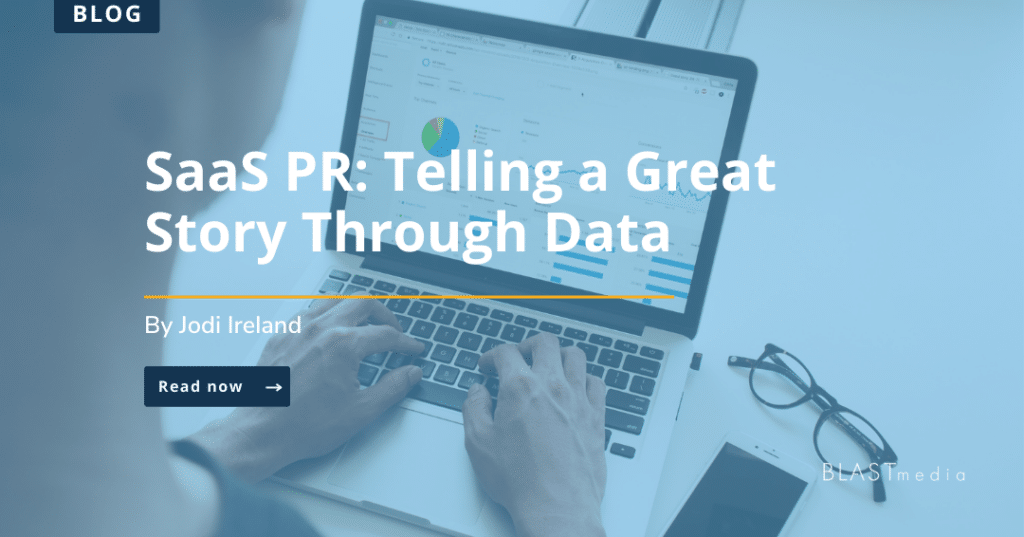
Data crunching isn’t enough: What’s the data’s story?
“Maybe stories are just data with a soul!” ~ Brene Brown
Every good story starts with a hook — finding the cure for a brain-eating fungus in a post-apocalyptic world. Stopping the Empire from overtaking the galaxy. Playing a series of kids’ games where to lose is to die, but winning it all means making bank.
And some stories rely on data to hook their audiences. Numbers alone don’t necessarily make an impact — but when B2B SaaS marketers, PR pros (and honestly, anyone else reliant on numbers) weave a narrative around the data, presenting it in context and framing its broader implications? That’s when the magic happens.
What is data storytelling?
Data storytelling allows SaaS PR professionals to help their clients leverage complex data and analytics to build a compelling narrative that tells a specific story via graphs, charts and other visuals while informing and influencing a particular audience. When executed well, data storytelling:
- Adds a human touch to data.
- Elevates the value of data and insights by interpreting and highlighting the key points of complex information.
- Helps explain data patterns and trends to non-technical audiences.
- Builds credibility as an industry thought leader.
- Improves data literacy by guiding people and teaching them how to read — and understand — data visualizations.
You’ve got the data. Now what?
Interesting data stories include three main elements: the data, visuals and a narrative. These steps will help you transform your raw data into an interesting story.
- Understand the question. Have you determined what question you want to answer first? If sales fell sharply last year among a certain demographic, do you know why? Knowing what you’re looking for will lead you to the best resources for the answer — whether it’s data about a product mix, marketing targets or customer preferences.
- Know the audience. Customize your presentation to suit them — are you sharing this story with the marketing team? Executive leadership? Board members? What’s their familiarity with the topic, problem or situation? How does it affect them? Are different presentation styles more effective than others? Can they process high levels of detail? These insights will shape your narrative approach.
- Analyze your data. You can’t create an interesting story without understanding the underlying data’s structure. Evaluate both the structure and quality, and highlight critical characteristics — patterns, format and completeness. You can even use a data management tool to confirm accuracy and validity.
- Organize and present your data consistently. Sometimes you might need to standardize formats (75% vs. .75). You may find other anomalies addressed via deduplicating, enriching or parsing. Look to other sources if your data set is incomplete.
- Craft your data story. Effectively using charts, graphs and other data visuals requires knowing how people perceive them. Some people want the big picture at a glance to understand the message’s value. Others want to drill down into the granular, nitty-gritty details.
In what order will you present the information to generate a maximum effect? Anticipate questions people might ask about a specific visual. The first chart might show decreased sales and the second might explain why. Think about the trends your research uncovered and organize your presentation into a logical path.
Embrace a “less is more” approach by building a story in layers. Use multiple visuals (instead of cramming everything onto one slide) so your audience won’t feel overwhelmed. Presenting everything on one crowded chart drowns out important messages. Divide the information among multiple consecutive charts, and use animations to reflect changes or add emphasis and help the story flow.
Give some love to the text accompanying the charts, which often catch the eye first. Go beyond mere labels and include a brief explanation of what it shows. Incorporate text annotations to highlight important details.
Champion simplicity. A line chart or bar graph often works well to present information — use color, arrows, circles or other simple graphics to add visual interest.
Take a look.
Don’t just take it from us SaaS PR pros, though. We pulled some of our favorite articles that do an exemplary job of weaving data storytelling into the overall narrative to educate, entertain and provoke thought.
- CMOs can’t defend what they can’t define — This article presents multiple visuals to illustrate the challenges CMOs face with explaining the challenges they face with explaining how their teams generate value.
- Where we’re spending our screentime, in 3 charts — This article uses a bar chart and two different line graphs to show where and how Americans are using devices to consume content.
- Visualizing 500,000 deaths from COVID-19 in the U.S. — This article presents multiple visuals to help people conceptualize a huge number, weaving graphics and content to make comparisons and clarify the toll of the global health epidemic.
We don’t make business decisions based on logic alone. Sure, analysis drives business thinking, but a barrage of numbers doesn’t inspire and motivate as effectively as a good story. Well-told stories create a shared human experience.
And let’s face it. Unless you’re a statistician, you’re unlikely to remember the numbers. Data in a vacuum? Pretty bland and unremarkable. But storytelling allows us to mold abstract, dry numbers into a captivating and interesting story. And we’re far more likely to remember a story than cold, hard numbers. Want to make sure your data makes a lasting impression? Go ahead and stretch your narrative muscles.
